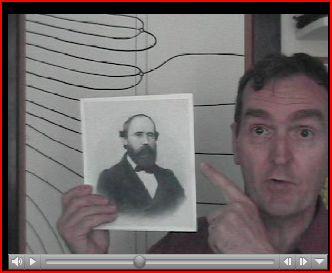
John Derbyshire, auteur de "Prime Obsession" (Dans le jungle des nombres premiers ), est journaliste, romancier, essayiste, "Pop-math author",
Sur son site, il nous propose son interprétation de la chanson "Where are the zeros of Zeta of s"
Cliquer sur l'image
Where are the zeros of zeta of s ?
G.F.B. Riemann has made a good guess,
They’re all on the critical line, sai he,
And their density’s one over 2pi log t.
This statement of Riemann’s has been like trigger
And many good men, with vim and with vigor,
Have attempted to find, with mathematical rigor,
What happens to zeta as mod t gets bigger.
The efforts of Landau and Bohr and Cramer,
And Littlewood, Hardy and Titchmarsh are there,
In spite of their efforts and skill and finesse,
(In) locating the zeros there’s been no success.
In 1914 G.H. Hardy did find,
An infinite number that lay on the line,
His theorem however won’t rule out the case,
There might be a zero at some other place.
Let P be the function pi minus li,
The order of P is not known for x high,
If square root of x times log x we could show,
Then Riemann’s conjecture would surely be so.
Related to this is another enigma,
Concerning the Lindelof function mu(sigma)
Which measures the growth in the critical strip,
On the number of zeros it gives us a grip.
But nobody knows how this function behaves,
Convexity tells us it can have no waves,
Lindelof said that the shape of its graph,
Is constant when sigma is more than one-half.
Oh, where are the zeros of zeta of s ?
We must know exactly, we cannot just guess,
In orer to strengthen the prime number theorem, _The integral’s contour must not get too near ’em.
André Weyl has improved an old Riemann’s find guess
By using a fancier Zeta of s
He proves that the zeros are where they should be
Provided that the characteristic is p.
There’s a moral to draw from this long tale of wow,
that every young genius among you must know
If you tackle a problem and seem to get stuck
Just take it mod p and you have better luck.
L'hypothèse de Riemann est une conjecture formulée en 1859 par le mathématicien Bernhard Riemann. Elle dit que les zéros non triviaux de la fonction zêta de Riemann ont tous pour partie réelle 1/2. Sa démonstration améliorerait la connaissance de la répartition des nombres premiers.
Cette conjecture constitue l'un des problèmes non résolus les plus importants des mathématiques du début du XXIe siècle : elle est l'un des fameux problèmes de Hilbert proposés en 1900, et fait l'objet d'un des problèmes Clay pour le troisième millénaire, doté d'un prix d'un million de dollars américains.

